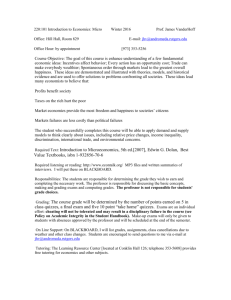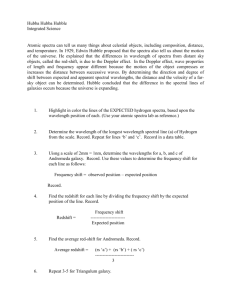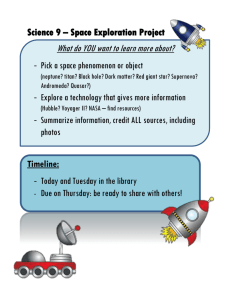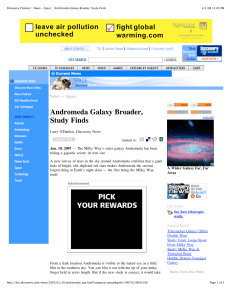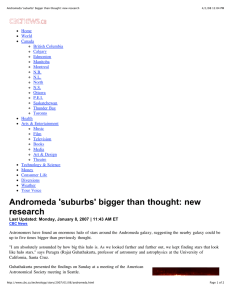Document 10536957
advertisement
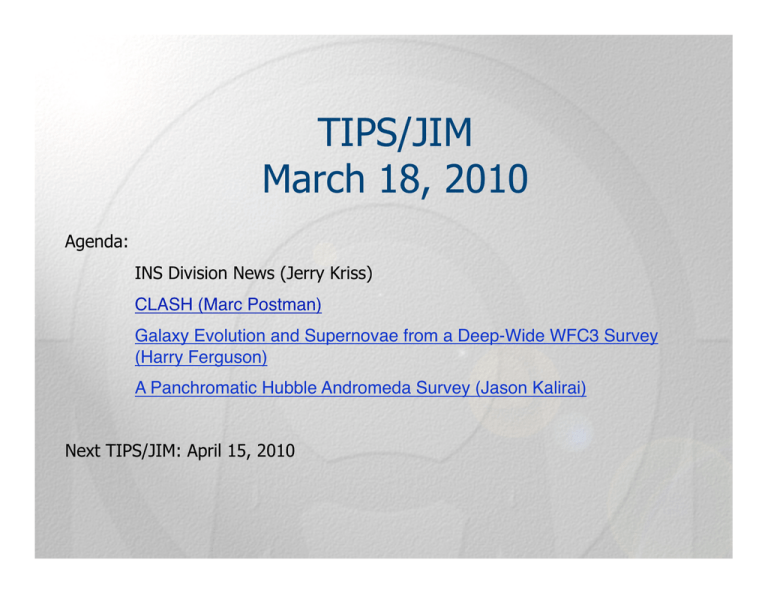
TIPS/JIM March 18, 2010 Agenda: INS Division News (Jerry Kriss) CLASH (Marc Postman) Galaxy Evolution and Supernovae from a Deep-Wide WFC3 Survey (Harry Ferguson) A Panchromatic Hubble Andromeda Survey (Jason Kalirai) Next TIPS/JIM: April 15, 2010 Instruments Division News March 18th 2010 The Division is reminded of the “Workplace Harassment” training program announced by Heather Sherbert this week. Note that this has not been issued in response to any incident but is a routine requirement of AURA and all staff, AURA, ESA, CSC and CSA need to complete this online program. It should take about 2-3 hours of your time. The JWST Proposal & Planning Systems Design Review is coming up on March 23rd and 24th. Those interested in attending are reminded to register with Karen Keidel by March 19th. The Cycle 18 HST deadline has come and gone since the last TIPS/JIM meeting. We received a total of 1051 proposals for 23,096 prime orbits, which included 872 GO proposals and 128 archive proposals (for $11.4M). The breakdown of the requested time by instrument is approximately: ACS 19%, COS 16%, FGS 2%, NICMOS 3%, STIS 15% and WFC3 45%. Today's presentations concern the Multi-Cycle Treasury programs, something we will all be involved with in some way over the coming years. To give some perspective, just over 2,000 orbits will be invested in these programs which is close to the total time allocated to a single cycle of GO programs. TIPS/JIM March 18, 2010 Agenda: INS Division News (Jerry Kriss) CLASH (Marc Postman) Galaxy Evolution and Supernovae from a Deep-Wide WFC3 Survey (Harry Ferguson A Panchromatic Hubble Andromeda Survey (Jason Kalirai) Next TIPS/JIM: April 15, 2010 . Marc Postman (P.I.) Megan Donahue Dani Maoz Stella Seitz Matthias Bartelmann Rosa Gonzales-Delgado Elinor Medezinski Keiichi Umetsu Narciso Benitez Holland Ford Leonidas Moustakas Arjen van der Wel Larry Bradley Leopoldo Infante Eniko Regoes Wei Zheng Tom Broadhurst Daniel Kelson Adam Riess Adi Zitrin Dan Coe Ofer Lahav Piero Rosati Deep HST image of massive cluster R∝ θEinstein NArcs R WHERE IS THE RESULTING SPATIAL RESOLUTION OF THE DARK MATTER MAP Simulation of dark matter around a forming cluster (Springel et al. 2005) Both strong AND weak lensing measurements are needed to make accurate constraints on the DM profile. CLASH data will allow us to definitively derive the representative equilibrium mass profile shape and robustly measure the cluster DM mass concentrations and their dispersion as a function of cluster mass and their evolution with redshift. Abell 209 MACS 0329-0211 RXJ 0647+7015 Abell 383 core MACS 0717+3745 RXJ 1347-1145 Abell 611 Abell 963 Abell 2261 CLJ1226+3332 MACS 0744+3927 MACS 1115+0129 MACS 1149+2223 MACS 1206-0847 RXJ 1423+2404 MS-2137 core RXJ 1702+3536 RXJ 2129+0005 28.5' 3.4' RXJ1347-1145 (z = 0.45) SUPRIME CAM Image ACS/WFC Image Why 14 filters? Mag distn of multiply lensed arcs in A1689 and CL0024 Will yield photometric redshifts with rms error of ~2% x (1 + z) for sources down to ~26 AB mag. With 14 filters, 80% photo-z completeness is reached at AB ~26 mag and useful redshift information is available for ~5 times as many lensed objects than would be possible solely from spectroscopically acquired redshifts. The blue and red solid curves show the expected number of z=8 and z=10 galaxies, respectively, to be discovered behind our 25 clusters as a function of magnitude in the detection band (F110W at z=8 and F140W at z=10). A significant advantage of searching for high-z objects behind strongly lensing clusters is that the lens model can also be used to discriminate between highly-reddened objects and truly distant, high-z objects as the projected position of the lensed image is a strong function of the source redshift. The parallel fields of the cluster survey provide the means to find ~10 SNe Ia at z >1 and would double the number of known SNe Ia at z > 1.2 (and potentially more, the precise number depending on the assumed time delay). CLASH is done WFC3 Parallels Cluster Pointings ACS Parallels Footprint of our 2 ORIENT survey. ACS FOV in green, WFC3/IR FOV in red, WFC3/UVIS in magenta. The area of the complete 14-band coverage in the cluster center is 4.07 square arcminutes (88% of the WFC3/IR FOV). ~20o 6 arcmin. = 2.2 Mpc @ z=0.5 3.5 26.3 3 2.5 WFC3-UVIS ACS-WFC 27.8 2 1.5 1 WFC3-IR 26.9 26.1 26.4 26.8 26.6 26.9 27.6 27.9 27.1 26.8 26.7 26.1 0.5 0 Limiting SNR=5 AB magnitudes (for flat spectrum point source) for each passband shown above TIPS/JIM March 18, 2010 Agenda: INS Division News (Jerry Kriss) CLASH (Marc Postman) Galaxy Evolution and Supernovae from a Deep-Wide WFC3 Survey (Harry Ferguson) A Panchromatic Hubble Andromeda Survey (Jason Kalirai) Next TIPS/JIM: April 15, 2010 Galaxy Evolution and Supernovae from a Deep-Wide WFC3 Survey • WFC3 IR observations of 5 well-studied reference fields at high galactic latitude: – The GOODS fields • Encompass the deepest fields from HST, Spitzer, Chandra, the VLA, and soon Herschel – The Extended Groth Strip – A small portion of the COSMOS field – The UKIRT Ultradeep Survey Field • Optimized for studies of galaxy evolution at z~2-10 • Optimized for supernova cosmology Theories crumble, but good observations never fade.— Harlow Shapley Merger of two similar proposals • Sandy Faber’s team proposed a ‘wedding cake’ strategy with 2-orbit depth in the three non-GOODS fields, and 50% of GOODS to 15-orbit depth. • Our team proposed to cover both GOODS fields to intermediate depth and to measure supernovae spectra and light curves. We also proposed UV observations for GOODS-N. • The TAC liked the wedding cake, the supernova followup and the UV observations. • Teams were merged and told to try to preserve these features. 90 Co-investigators Supernova Cosmology • Refine the only constraints we have on the time variation of w, on a path to more than doubling the strength of this crucial test of a cosmological constant by the end of HSTʼs life. Supernova Cosmology • Obtain a direct, explosion-model-independent measure of the evolution of Type Ia supernovae as distance indicators at z > 1.5, independent of dark energy. Supernova Cosmology • Provide the first measurement of the SN Ia rate at z>1.5 to distinguish between prompt and delayed SN Ia production and their corresponding progenitor models. Supernova Cosmology • Refine the only constraints we have on the time variation of w, on a path to more than doubling the strength of this crucial test of a cosmological constant by the end of HSTʼs life. Supernova Cosmology Cosmic Dawn • Greatly improve the estimates of the evolution of stellar mass, dust and metallicity at z = 4-8 by combining WFC3 data with very deep Spitzer observations. Cosmic Dawn • Improve by ~10x the constraints on the bright end of the luminosity function at z~7 and 8, and make z~6 measurements robust using proper 2-color Lyman break selection. Cosmic Dawn • Measure fluctuations in the near-IR background light, at sensitivities sufficiently faint and angular scales sufficiently large to constrain re-ionization models. Extragalatic background: Bock et al. 2006 • Integrated galaxy counts below previous detection limits form a lower EBL bound • Gamma-Ray bursts (e.g Aharonian et al. 2005) form upper bound • Direct detections are difficult due to the EBL’s faint intensity • Detections currently conflict WFC3 Fluctuation Measurements • • • Reioniza2on Simula2on from Trac and Cen 2007 Large θ Small θ The large angle (θ ~ 1/30 °) peak (green curve) is a linear-theory prediction of clustering of reionization sources. Small scale power is sensitive to the slope and normalization of the luminosity function. large area surveys with WFC3 can (barely) reach large angle peak Cosmic high-noon • Test models for the co-evolution of black holes and bulges via the most detailed census of interacting pairs, mergers, AGN, and bulges, aided by the most complete and unbiased census of AGN from Herschel, improved Chandra observations, and optical variability. Cosmic high-noon • Detect individual galaxy subclumps and measure their stellar mass, constraining the timescale for their dynamical-friction migration to the center leading to bulge formation. • Reveal the presence of fully formed passively evolving bulges out to z > 3, measure the bulge/disk ratio, and provide constraints on the relative ages of the bulge and disk populations. • Measure the rest-frame optical morphologies of passive galaxies up to z~2 and beyond, and combine with ACS data to quantify UV-optical color (age) gradients. Cosmic variance Observing strategy • Wide fields: – – – – ~750 sq. arcmin 2/3 orbits J (debating F125W vs. F110W) 4/3 orbits H (F160W) Half the GOODS area covered this way • GOODS Deep: – ~130 sq. arcmin – 12 orbit depth 4+4+4 in F105W+F125W+F160W – At least 12 orbits new ACS F814W • UV (GOODS-N): – ~70 sq. arcmin – Primary science is Lyman-escape fractions at z~2.5 – 3:1 ratio in F275W:F336W; leaning toward binning 2x2 Technical Issues • We need to reprocess and stack all the existing ACS data on these fields (for high-z galaxies): – With better geometric distortion corrections and astrometry than the original GOODS stacks – With CTE corrections (Anderson algorithm?) – Need alignment to WFC3 to within 0.1 pixel – Correcting crosstalk for the EBL fluctuations project • We are looking closely at image subtraction and galaxy morphology versus number & size of dithers • We need to worry about scattered earthshine for the CVZ orbits • Persistence, blobs, etc. will be a challenge for the EBL fluctuations measurement. TIPS/JIM March 18, 2010 Agenda: INS Division News (Jerry Kriss) CLASH (Marc Postman) Galaxy Evolution and Supernovae from a Deep-Wide WFC3 Survey (Harry Ferguson) A Panchromatic Hubble Andromeda Survey (Jason Kalirai) Next TIPS/JIM: April 15, 2010 Dr. Julianne Dalcanton (University of Washington) Dr. Eric F. Bell (University of Michigan) Dr. Luciana C. Bianchi (The Johns Hopkins University) Dr. Nelson C. Caldwell (Smithsonian Institution Astrophysical Observatory) Dr. Andrew Dolphin (Raytheon Company) Dr. Karoline Gilbert (University of Washington) Dr. Leo Girardi (Osservatorio Astronomico di Padova) Dr. Stephanie Gogarten (University of Washington) Dr. Karl D. Gordon (Space Telescope Science Institute) Dr. Puragra Guhathakurta (University of California - Santa Cruz) Dr. Paul W. Hodge (University of Washington) Dr. Jon A. Holtzman (New Mexico State University) Mr. L. C. Johnson (University of Washington) Dr. Jason S. Kalirai (Space Telescope Science Institute) Dr. C. S. Kochanek (The Ohio State University) Dr. Dustin Lang (Princeton University) Dr. Soeren S. Larsen (Universiteit Utrecht, Sterrekundig Instituut Netherlands) Dr. Tod R. Lauer (National Optical Astronomy Observatories) Dr. Adam Leroy (Associated Universities, Inc.) Dr. Jason Lee Melbourne (California Institute of Technology) Dr. Knut A.G. Olsen (National Optical Astronomy Observatories) Dr. Hans-Walter Rix (Max-Planck-Institut fur Astronomie) Mr. Keith Rosema (Random Walk Group) Dr. Abhijit Saha (National Optical Astronomy Observatories) Dr. Ata Sarajedini (University of Florida) Dr. Anil C. Seth (Smithsonian Institution Astrophysical Observatory) Dr. Evan D. Skillman (University of Minnesota) Dr. Krzysztof Z. Stanek (The Ohio State University) Mr. Dan Weisz (University of Minnesota) Dr. Benjamin F. Williams (University of Washington) T. Brown et al. (2003) Step 1: Come up with an Acronym 1.) ACS/WFC3 Exploratory Survey Of M31's Evolution (AWESOME) 2.) Hubble's Andromeda Panchromatic Panoramic Imaging (HAPPI -- this is a direct reference to ANGST and ANGRRR). 3.) Stellar Evolution in Andromeda Legacy Survey (SEALS) 4.) Andromeda Survey of Stellar Evolution and Time (ASSET) 5.) Andromeda Survey of Stellar Evolution and Stellar States (ASSESS) 6.) A Panchromatic Hubble Andromeda Treasury (PHAT) 7.) The Great Andromeda Survey (GAS). 8.) The Andromeda Project 9.) Project Andromeda 10.) The Andromeda Hubble Atlas (AHA) 11.) Quarter of Andromeda Treasury Survey (QATS) 12.) Panchromatic Hubble Andromeda and Triangulum Survey (PHAT Survey) 13.) Panchromatic Imaging of Triangulum and Andromeda (PITA) 14.) Multiwavelength Mapping of M31 and M33 (MMMM) 15.) Wide-field Hubble Imaging of M31/M33 (WHIM) 16.) Wide-field High-resolution Imaging: Panchromatic Landscape of Andromeda and its Satellite with Hubble (WHIPLASH) 17.) Detailed Imaging of Nearby Galaxies: Boring into Andromeda and Triangulum (DINGBAT) 18.) Panchromatic Imaging of Nearby Galaxies (PING) 19.) Wide-field Imaging of Nearby Galaxies: Stellar Populations in Andromeda and its Neighbor (WINGSPAN) 20.) Wide-field Hubble Imaging of M31/M33 Stars In Color: Astrophysical Labratories (WHIMSICAL) 21.) Stellar Populations of Andromeda and Triangulum (SPAT) 22.) Near-infrared and Optical Survey of Two Resolved and Extended SpiralS (NOSTRESS) 23.) Hubble Ultrawide Multiwavelength M31 and M33 Survey (HUMMMS) 24.) Multiwavelength Andromeda and Triangulum Ultrawide Realization Experiment (MATURE) 25.) Multiwavelength M31 and M33 Ultrawide Survey Campaign Legacy Experiment (MMMUSCLE) 26.) Multiwavelength Andromeda and Triangulum Hubble Survey (MATHS) 27.) Survey with Hubble of Andromeda and Triangulum (SHAT) -- just kidding. 28.) Hubble Areal Mapping of M31 and M33 (HAMMM) 29.) Panchromatic Ultrawide M31 and M33 Extragalactic Legacy (PUMMEL) 30.) Panchromatic Hubble Ultrawide Galaxy Legacy Y-word (PHUGLY) -- also just kidding. 31.) Resolving Andromeda and Triangulum (RAT) 32.) Triangulum/Andromeda Survey Program (TASP) 33.) Galaxy Laboratories: Observing Andromeda and Triangulum (GLOAT) 34.) Galaxy Laboratories Observed with Hubble: the Andromeda and Triangulum Survey (GLOwHATS) Step 1: Come up with an Acronym …and the winner is: Panchromatic Hubble Andromeda and Triangulum Survey (PHAT Survey) (1194 orbits) Step 2: TAC chops off 360 orbits…ouch!!! Step 1: Come up with an Acronym 1.) ACS/WFC3 Exploratory Survey Of M31's Evolution (AWESOME) 2.) Hubble's Andromeda Panchromatic Panoramic Imaging (HAPPI -- this is a direct reference to ANGST and ANGRRR). 3.) Stellar Evolution in Andromeda Legacy Survey (SEALS) 4.) Andromeda Survey of Stellar Evolution and Time (ASSET) 5.) Andromeda Survey of Stellar Evolution and Stellar States (ASSESS) 6.) A Panchromatic Hubble Andromeda Treasury (PHAT) 7.) The Great Andromeda Survey (GAS). 8.) The Andromeda Project 9.) Project Andromeda 10.) The Andromeda Hubble Atlas (AHA) 11.) Quarter of Andromeda Treasury Survey (QATS) 12.) Panchromatic Hubble Andromeda and Triangulum Survey (PHAT Survey) 13.) Panchromatic Imaging of Triangulum and Andromeda (PITA) 14.) Multiwavelength Mapping of M31 and M33 (MMMM) 15.) Wide-field Hubble Imaging of M31/M33 (WHIM) 16.) Wide-field High-resolution Imaging: Panchromatic Landscape of Andromeda and its Satellite with Hubble (WHIPLASH) 17.) Detailed Imaging of Nearby Galaxies: Boring into Andromeda and Triangulum (DINGBAT) 18.) Panchromatic Imaging of Nearby Galaxies (PING) 19.) Wide-field Imaging of Nearby Galaxies: Stellar Populations in Andromeda and its Neighbor (WINGSPAN) 20.) Wide-field Hubble Imaging of M31/M33 Stars In Color: Astrophysical Labratories (WHIMSICAL) 21.) Stellar Populations of Andromeda and Triangulum (SPAT) 22.) Near-infrared and Optical Survey of Two Resolved and Extended SpiralS (NOSTRESS) 23.) Hubble Ultrawide Multiwavelength M31 and M33 Survey (HUMMMS) 24.) Multiwavelength Andromeda and Triangulum Ultrawide Realization Experiment (MATURE) 25.) Multiwavelength M31 and M33 Ultrawide Survey Campaign Legacy Experiment (MMMUSCLE) 26.) Multiwavelength Andromeda and Triangulum Hubble Survey (MATHS) 27.) Survey with Hubble of Andromeda and Triangulum (SHAT) -- just kidding. 28.) Hubble Areal Mapping of M31 and M33 (HAMMM) 29.) Panchromatic Ultrawide M31 and M33 Extragalactic Legacy (PUMMEL) 30.) Panchromatic Hubble Ultrawide Galaxy Legacy Y-word (PHUGLY) -- also just kidding. 31.) Resolving Andromeda and Triangulum (RAT) 32.) Triangulum/Andromeda Survey Program (TASP) 33.) Galaxy Laboratories: Observing Andromeda and Triangulum (GLOAT) 34.) Galaxy Laboratories Observed with Hubble: the Andromeda and Triangulum Survey (GLOwHATS) Technical Goal - Resolve M31 into 100 million stars. - Survey provides temperatures for O through M spectral types, with simultaneous extinction mapping. Science Goals - Stellar Initial Mass Function and Variations with Environment (SFR intensity, metallicity, density). - Study young and old star clusters over a range of ages and metallicity (calibration of models). - Constrain cluster formation and evolutionary processes. - Measure energetics and timescales of ISM through interplay of gas and spatially resolved SFHs. - Characterize full SEDs (spatially resolved) of x-ray binaries, SN remnants, Cepheids, PN, WR stars, background AGN, and transients (e.g., counterparts and association with surrounding population properties). - Provide rich probes of gas phase and interaction with SF, through sub-arcsecond extinction mapping. Bonus - Spatially resolve SFH in a Galactic bulge and disk, fully sampled over spiral arms. - Map the spiral dynamics, growth of galaxy disk and spheroid, role of tidal interactions/accretion. Massey et al. (2006) Requirements - Wide-field, high-resolution, ultra-sensitive imaging in the UV, optical, and NIR ACS + WFC3 Observing Plan -Thanks to ACS and WFC3 teams, plus Merle, Bill, and Alan! Synergistic Spectroscopy - Keck/DEIMOS 2010 proposal submitted on Friday (PI Guhathakurta)!
